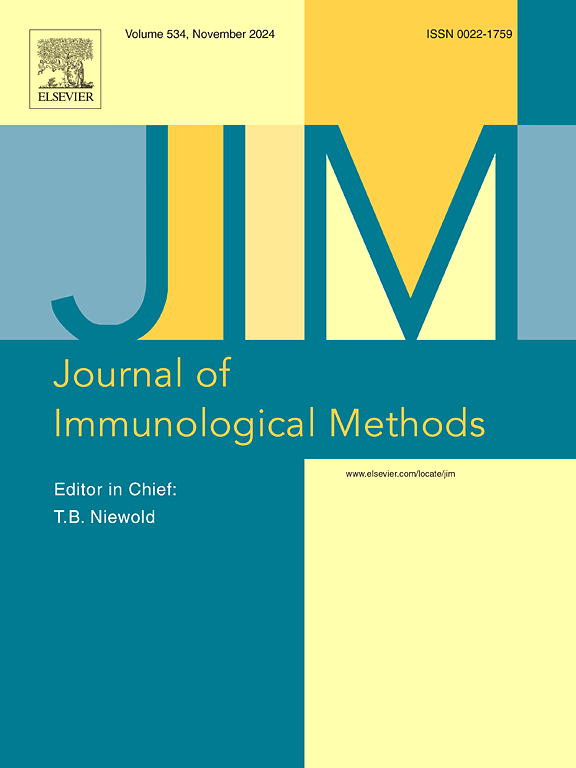Anti-chicken and anti-pigeon immunoglobulin G testing in patients with bird-related fibrotic hypersensitivity pneumonitis
IF 1.6
4区 医学
Q4 BIOCHEMICAL RESEARCH METHODS
引用次数: 0
Abstract
Background
One of the inciting antigens for fibrotic hypersensitivity pneumonitis (HP) is avian. It is controversial whether chickens are the inciting antigen of bird-related fibrotic HP; the anti-chicken immunoglobulin (Ig) G testing for bird-related fibrotic HP patients was investigated.
Methods
Anti-pigeon IgG and anti-chicken IgG antibodies by mainly enzyme-linked immunosorbent assay (ELISA) were measured in patients with bird-related fibrotic HP. We included bird-related fibrotic HP patients who had undergone histopathological examination and who had a positive inhalation challenge test.
Results
We included 44 patients with bird-related fibrotic HP and 48 with fibrotic interstitial lung diseases other than fibrotic HP. The mean titers of anti-pigeon IgG antibody by ELISA were 0.659 ± 0.381 and 0.494 ± 0.187 in the bird-related fibrotic HP and control groups, respectively (p = 0.012). Those of anti-chicken IgG antibody were 0.345 ± 0.189 and 0.376 ± 0.167, respectively (p = 0.457). No significant correlation was found between anti-pigeon IgG testing by ELISA and anti-chicken IgG testing (r = 0.45, p = 0.45). In patients with bird-related fibrotic HP, annual FVC changes were significantly different (p = 0.001), with the higher titer group improving by 0.4 % and the lower titer group decreasing by 4 %. Similarly, no significant differences in annual FVC changes were observed between the higher and lower anti-chicken IgG antibody titer groups among bird-related fibrotic HP patients.
Conclusion
Serum IgG testing for chicken serum was less effective in diagnosing or predicting the disease progression of bird-related fibrotic HP than that for pigeon serum.
禽相关性纤维化超敏性肺炎患者抗鸡、抗鸽免疫球蛋白G检测。
背景:纤维化超敏性肺炎(HP)的刺激抗原之一是禽。鸡是否是禽源性纤维化HP的激发抗原存在争议;研究了禽类相关性纤维化HP患者的抗鸡免疫球蛋白(Ig) G检测。方法:采用酶联免疫吸附法(ELISA)检测鸟源性纤维化HP患者的抗鸽IgG和抗鸡IgG抗体。我们纳入了接受组织病理学检查且吸入激发试验阳性的与鸟类相关的纤维化HP患者。结果:我们纳入了44例鸟类相关性纤维化HP患者和48例非纤维化HP的纤维化间质性肺疾病患者。禽相关纤维化HP和对照组抗鸽IgG抗体平均滴度分别为0.659 ± 0.381和0.494 ± 0.187 (p = 0.012)。抗鸡IgG抗体分别为0.345 ± 0.189和0.376 ± 0.167 (p = 0.457)。ELISA法检测抗鸽IgG与检测鸡IgG无显著相关性(r = 0.45,p = 0.45)。在鸟类相关性纤维化HP患者中,FVC的年变化有显著性差异(p = 0.001),高滴度组改善了0.4 %,低滴度组降低了4 %。同样,在禽类相关的纤维化HP患者中,抗鸡IgG抗体滴度较高和较低组之间的FVC年变化无显著差异。结论:鸡血清IgG检测对禽类相关性纤维化HP的诊断和预测效果低于鸽血清IgG检测。
本文章由计算机程序翻译,如有差异,请以英文原文为准。
求助全文
约1分钟内获得全文
求助全文
来源期刊
CiteScore
4.10
自引率
0.00%
发文量
120
审稿时长
3 months
期刊介绍:
The Journal of Immunological Methods is devoted to covering techniques for: (1) Quantitating and detecting antibodies and/or antigens. (2) Purifying immunoglobulins, lymphokines and other molecules of the immune system. (3) Isolating antigens and other substances important in immunological processes. (4) Labelling antigens and antibodies. (5) Localizing antigens and/or antibodies in tissues and cells. (6) Detecting, and fractionating immunocompetent cells. (7) Assaying for cellular immunity. (8) Documenting cell-cell interactions. (9) Initiating immunity and unresponsiveness. (10) Transplanting tissues. (11) Studying items closely related to immunity such as complement, reticuloendothelial system and others. (12) Molecular techniques for studying immune cells and their receptors. (13) Imaging of the immune system. (14) Methods for production or their fragments in eukaryotic and prokaryotic cells.
In addition the journal will publish articles on novel methods for analysing the organization, structure and expression of genes for immunologically important molecules such as immunoglobulins, T cell receptors and accessory molecules involved in antigen recognition, processing and presentation. Submitted full length manuscripts should describe new methods of broad applicability to immunology and not simply the application of an established method to a particular substance - although papers describing such applications may be considered for publication as a short Technical Note. Review articles will also be published by the Journal of Immunological Methods. In general these manuscripts are by solicitation however anyone interested in submitting a review can contact the Reviews Editor and provide an outline of the proposed review.

 求助内容:
求助内容: 应助结果提醒方式:
应助结果提醒方式:


